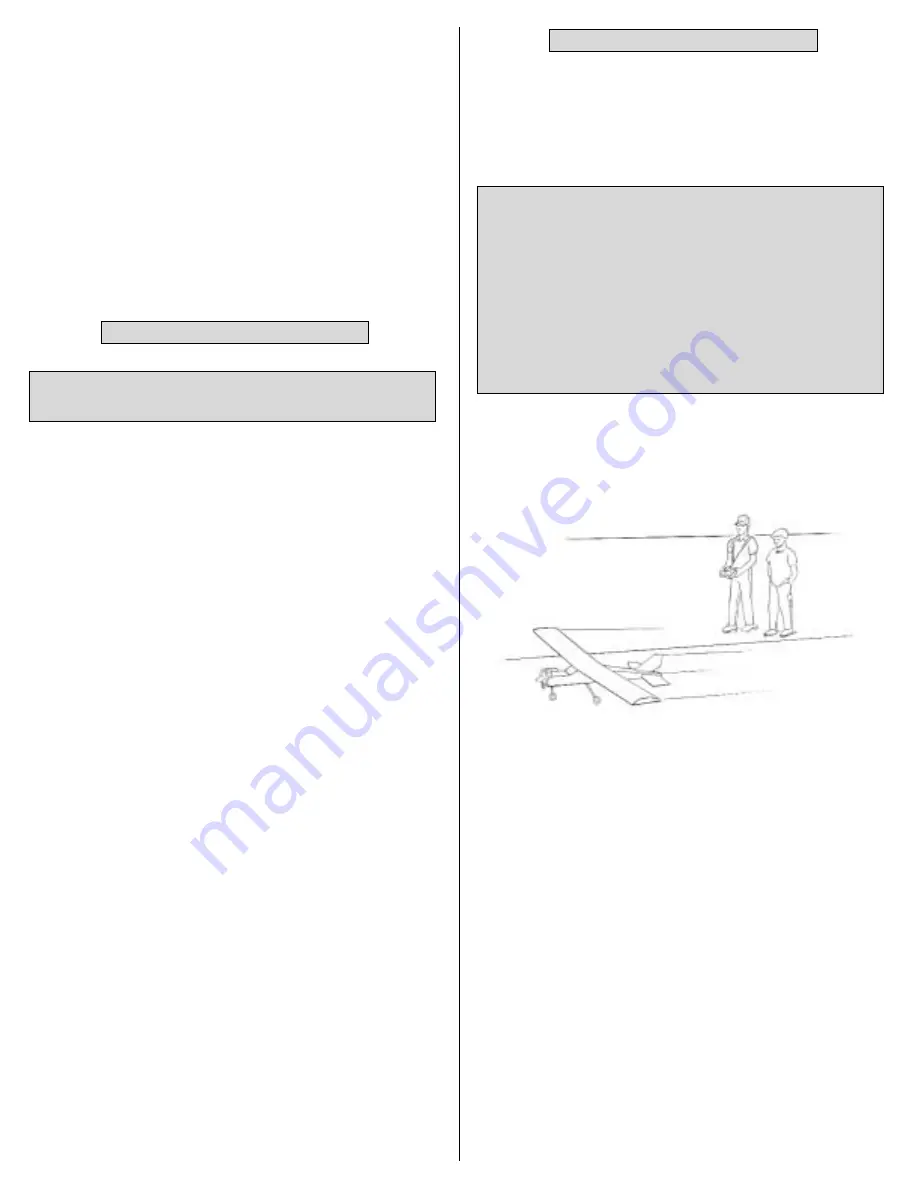
by the model and tell you what the controls are doing to confirm
that they operate correctly. You should be able to walk
approximately 100 feet from the model and still have control
without any “glitching” or inadvertent servo operation.
2. If everything operates correctly, return to the model and start
the engine. Perform the range check with your assistant holding
the plane with the engine running at various speeds. If the
servos chatter or move inadvertently, there may be a problem.
Do not fly the plane! With the assistance of your instructor,
look for loose servo connections or binding pushrods. Also be
certain you are the only one on your frequency, and that the
battery has been fully charged.
Keep all engine fuel in a safe place, away from high heat,
sparks or flames, as fuel is very flammable. Do not smoke near
the engine or fuel; and remember that engine exhaust gives off
a great deal of deadly carbon monoxide. Therefore, do not run
the engine in a closed room or garage.
Get help from an experienced pilot when learning to operate
engines.
Use safety glasses when starting or running engines.
Do not run the engine in an area of loose gravel or sand; the
propeller may throw such material in your face or eyes.
Keep your face and body as well as all spectators away from
the plane of rotation of the propeller as you start and run the
engine.
Keep these items away from the prop: loose clothing, shirt
sleeves, ties, scarfs, long hair or loose objects such as pencils
or screwdrivers that may fall out of shirt or jacket pockets into
the prop.
Use a “chicken stick” or electric starter to start the engine. Do
not use your fingers to flip the propeller. Make certain the glow
plug clip or connector is secure so that it will not pop off or
otherwise get into the running propeller.
Make all engine adjustments from behind the rotating propeller.
The engine gets hot! Do not touch it during or right after
operation. Make sure fuel lines are in good condition so fuel will
not leak onto a hot engine, causing a fire.
To stop a glow engine, cut off the fuel supply by closing off the
fuel line or following the engine manufacturer’s recommendations.
Do not use hands, fingers or any other body part to try to
stop the engine. Do not throw anything into the propeller of a
running engine.
The following flying instructions are in no way an endorsement
for learning to fly on your own, but are printed so you can know
what to expect and what to concentrate on while learning under
the tutelage of your instructor. Further, these flight instructions
may be referenced once you begin flying on your own.
Taxiing
Remember, it is assumed that your instructor is operating
the model for you.
Takeoff
If possible, takeoff directly into the wind. If you are experienced,
taking off in a crosswind is permissible (and sometimes
necessary–depending upon the prevailing wind conditions and
runway heading). Taking off into the wind will help the model roll
straight and also reduces ground speed for takeoff. Taxi the
model onto the runway or have an assistant carry it out and set
it down pointing down the runway into the wind. When ready,
gradually advance the throttle while simultaneously using the
left stick (rudder/nose wheel) to steer the model. Gain as much
speed as the runway and flying site will practically allow before
gently applying up elevator, lifting the model into the air. Be
ready to make immediate corrections with the ailerons to keep
the wings level, and be smooth on the elevator stick, allowing
the model to establish a gentle climb to a safe altitude before
making the first turn (away from yourself). Do not “yank” back
the elevator stick forcing the plane into too steep of a climb
which could cause the model to stall and quit flying.
Flight
Once airborne, maintain a steady climb and make the initial
turn away from the runway. When at a comfortable, safe altitude
IMPORTANT: If you do insist on flying on your own, you
must be aware of your proximity to R/C club sites. If there is
an R/C site within six miles of where you are flying, and if
you are operating your model on the same frequency at the
same time as somebody else, there is a strong possibility
that one or both models will crash due to radio interference.
There is great potential for an out-of-control model to cause
property damage and/or severe personal injury. We
strongly urge you to fly at a R/C club site where frequency
control is in effect so you can be assured you will be the only
one flying on your channel.
Flying
Failure to follow these safety precautions may result in
severe injury to yourself and others.
Engine Safety Precautions
22



































